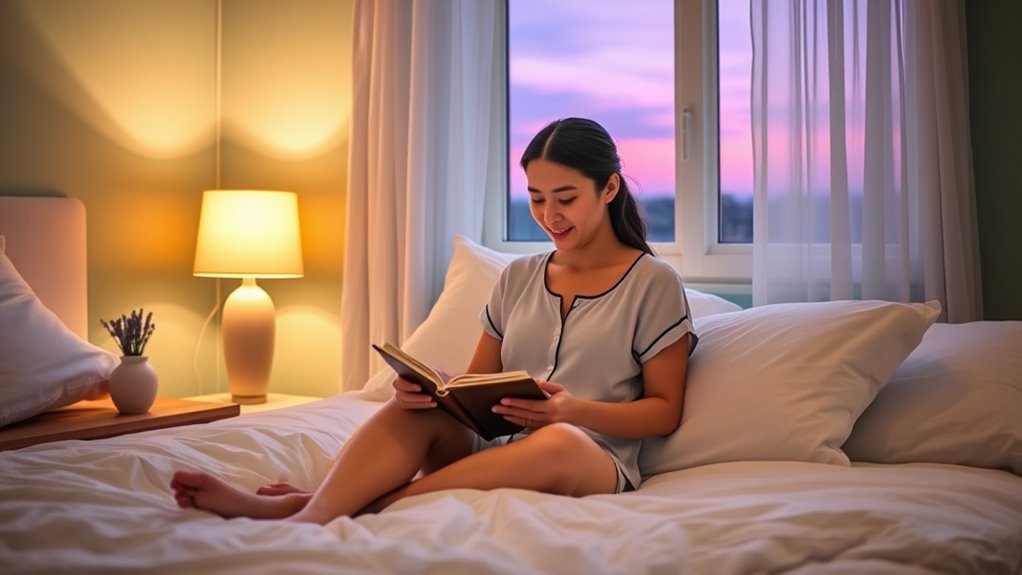I've discovered that mastering positive manifestation techniques has transformed my nightly routine into a gateway for deep, restorative sleep. Through years of experimenting with various methods, I've learned that combining mindful practices with intentional gratitude creates a powerful formula for relaxation. If you're struggling with restless nights or racing thoughts, these proven techniques will help you tap into your mind's natural ability to manifest peaceful slumber.
Preparing Your Mind and Space for Nighttime Manifestation
Before you can effectively manifest your desires during sleep, you'll need to prepare both your mindset and environment for ideal results.
I recommend starting with journaling to release negative thoughts and practicing gratitude to elevate your emotional state. These practices create powerful subconscious alignment with your goals. Guided meditation sessions can enhance your relaxation and emotional release before bedtime. Engaging in self-reflection through journaling can also deepen your understanding of your desires.
Create a mindful environment by dimming lights, removing electronic distractions, and incorporating calming scents like lavender.
Set the stage for manifestation by creating a serene space – soft lighting, no devices, and soothing aromatherapy.
Place written affirmations under your pillow as physical anchors for your intentions. Keep your manifestation tools within easy reach of your bed.
Focus on one specific goal to channel your energy effectively.
Practice the 4-2-6 breathing pattern to activate your relaxation response.
Sleep-Friendly Visualization and Affirmation Methods
Mastering sleep-friendly visualization and affirmation methods requires combining sensory-rich imagery with purposeful positive statements. I'll show you how to access your mind's power by creating sensory-rich environments in your imagination while using targeted affirmations. Think of descending a staircase to a peaceful beach, feeling each step bring deeper relaxation through dynamic progression. The practice serves as a powerful stress relief mechanism when used consistently, and it also enhances emotional intelligence by fostering a deeper connection with your inner self.
| Scene | Visualization | Affirmation |
|---|---|---|
| Beach | Warm sand, gentle waves | I am peaceful and calm |
| Forest | Rustling leaves, cool breeze | I am safe and protected |
| Mountain | Crisp air, soaring views | I am strong and capable |
| River | Flowing water, smooth stones | I flow easily into sleep |
| Garden | Sweet flowers, soft grass | I grow more peaceful each day |
Try these combinations tonight, letting your mind drift naturally between scenes while repeating the affirmations. You'll find yourself sliding into restorative sleep more easily than ever before.
The Power of Gratitude Before Bedtime

Building on our visualization methods, let's explore how gratitude can transform your nightly rest.
I've discovered that practicing gratitude before bed delivers remarkable sleep quality benefits, helping you fall asleep faster and wake up more refreshed. This practice enhances self-awareness and can lead to deeper emotional intelligence, further promoting relaxation.
When you focus on appreciation rather than daily stresses, you'll naturally shift into a more relaxed state.
I recommend starting with a simple gratitude journal where you'll list three blessings from your day. Combine this with slow, mindful breathing to amplify the calming effects.
Research shows getting 46 extra minutes of sleep can significantly boost your gratitude levels and emotional well-being.
The science backs this up – grateful people experience better sleep regardless of their personality type.
They've lower stress hormones, fewer nighttime disruptions, and improved daytime energy.
Mindful Breathing and Relaxation Practices
While many seek complex solutions for better sleep, the foundation lies in mindful breathing and relaxation practices.
I've found that simple diaphragmatic techniques, like the 4-7-8 method, can trigger your body's natural relaxation response and boost melatonin production. Incorporating healthy habits into your routine can further enhance your overall well-being and sleep quality.
Start with rhythmic patterns that feel natural to you – even shorter cycles work well for beginners. I recommend combining progressive relaxation with body scans, systematically releasing tension from your toes to your head.
Find your own comfortable breathing rhythm and pair it with a gentle body scan to gradually release physical tension.
This approach taps into your brain's neuroplasticity effects, actually rewiring stress responses over time.
What I love most about these practices is how they create emotional balance through simple, conscious breathing.
The soothing practice of alternate nostril breathing helps reduce anxiety while promoting mental tranquility.
Creating a Positive Pre-Sleep Journaling Routine

Beyond mindful breathing, a pre-sleep journaling practice can transform your nightly routine into a powerful manifestation ritual. I recommend dedicating 15 minutes each evening to write freely about your positive experiences and future visions.
Your journaling prompts should focus on gratitude, present-tense affirmations, and next-day planning to release mental burdens. Research shows that cognitive activation through bedtime writing significantly improves mental clarity and problem-solving abilities. Engaging in this practice can also enhance your ability to track progress towards personal development goals.
To maximize your evening rituals, place written affirmations under your pillow while visualizing your desired outcomes. Combine this with essential oils to enhance your sensory experience.
Write as if your goals are already achieved – this aligns your subconscious mind with your intentions. Remember to avoid dwelling on worries or getting caught up in perfect grammar.
Instead, let your journaling flow naturally, focusing on solutions and emotional processing to create the peaceful mindset needed for restful sleep.
Frequently Asked Questions
How Long Does It Typically Take to See Results From Nighttime Manifestation Practices?
I've found timeframes for results vary greatly with individual experiences, but you'll typically notice shifts within weeks to months when practicing consistently, depending on your specific intention's complexity.
Can Manifestation Techniques Help With Chronic Insomnia and Sleep Disorders?
Picture yourself floating peacefully. I've found manifestation benefits can support traditional insomnia solutions, but I recommend combining them with proven cognitive behavioral techniques for the most effective sleep improvement.
Should I Practice Manifestation Techniques if I Take Sleep Medication?
I recommend using manifestation alongside your sleep medication. When practiced safely, they can work together. Just inform your doctor and monitor how both affect your sleep patterns.
What Happens if I Fall Asleep During Visualization Exercises?
I'll assure you that falling asleep during visualization enhances the benefits. Your subconscious keeps processing while you dream, making the practice even more impactful. Let yourself drift – it's perfectly natural.
Can Practicing Manifestation With a Partner Enhance the Results?
Like two streams joining to form a powerful river, practicing manifestation with a partner creates dynamic synergy. When you align your shared intentions, you'll amplify each other's manifestation power exponentially.

